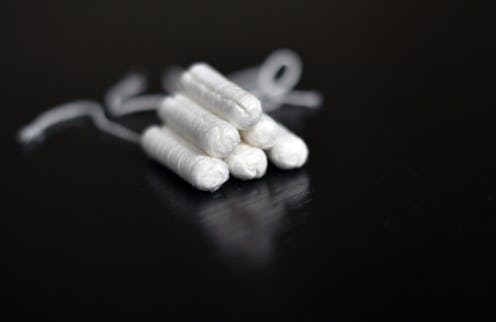Life
7 Period Inventions That Changed History
Like it or not — and it's probably safe to say that at least a few people who get periods aren't exactly thrilled about it — menstruation has been around since the dawn of time. As painfully obnoxious as your monthly may be, though, people who menstruate in the modern day actually have it pretty easy, and it's at least partially thanks to period innovations throughout history. Periods are certainly still stigmatized in virtually every society — just look at the backlash facing women who free bleed — but the fact remains that menstrual products available in industrialized societies today allow people to go about their daily business a whole lot easier than they used to.
Unfortunately, this wasn't (and still isn't, in some areas) always the case. Of course, because history was usually written by men, it's difficult to know with any certainty how societies viewed menstruation through the ages. However, it was associated with uncleanliness in many cultures, and people have had some pretty odd beliefs about periods in the past: An ancient Roman naturalist wrote that contact with menstrual blood could kill crops and sour wine (which obviously isn't true), and prior to the 19th century, scientists didn't even realize that menstruation was linked to ovulation.
Between the stigmatization and misinformation, it's perhaps no surprise that innovative menstrual products were few and far between throughout history — but every so often, legitimately useful solutions were invented. Let's look at seven below.
1. Ancient Pads
To understand how menstrual products have changed over time, it's important to understand where they started. Despite suggestions that women in ancient Greece used to wrap wooden sticks in linen to form an early variation of the tampon, historians have actually debunked this as a myth. This isn't to say that women didn't use tampons in some capacity, but they were often reserved for medicinal treatments or contraception rather than soaking up menstrual fluid.
Instead, women in many ancient cultures appear to have used loincloths made of cheap, absorbent fabrics like linen or cotton, which some poor soul would have to launder each month. (According to The Atlantic, Indonesian women are believed to have used vegetable fibers, and women in some parts of Africa used grass.) The Museum of Menstruation writes that these products likely took the form of a "pad with a belt or something similar," which eventually developed into...
2. Sanitary Belts
Anyone who's had to fashion a temporary pad out of toilet paper knows how impossible it is to (literally) keep it in your pants. As a solution, enterprising souls around the world created "sanitary belts" to hold menstrual rags, and later disposable pads, in place. Even back in the 1500s, Queen Elizabeth I of England owned girdles presumably designed for this purpose, although the first advertisement for a commercial sanitary belt didn't appear until the late 19th century.
3. The Tampon
Cue the angels singing: The first "modern" tampon, aka the variety that comes with an applicator, was finally created and patented by Earl Haas in 1931.
4. Menstrual Cups
Around the same time as the tampon, the first modern menstrual cup, which collects your blood for you to rinse out later, was patented in 1937 by American actress Leona Chalmers. Although most people didn't take to the idea at the time, it's been making a comeback since the beginning of the 21st century, at least partly due to their eco-friendly nature.
5. Adhesive Pads
After disposable pads became common in the late 19th century, they didn't see any major change again until 1969, when Stayfree began manufacturing the first self-adhesive mini-pads. Many women take adhesive strips for granted today, but until the 1970s, sanitary belts and safety pins were still common.
Interestingly enough, there's been a resurgence in reusable pads in recent years; like menstrual cups, much of the interest appears to stem from their comparative environmental friendliness.
6. Period-Safe Underwear
Over the last few years, some manufacturers have experimented with period-safe underwear, which claim to be made of material that absorbs your menstrual blood — or serves as a backup to tampons or pads if you have a heavier flow. THINX was the first company to begin selling the leak-proof underwear on a large scale, although others have followed suit since then. It's also worth noting that THINX has been particularly forward-thinking in terms of its marketing, which has been praised for its efforts to normalize periods and the inclusion of transgender models. (Because it's not just women who get periods, y'all.)
7. Subscription Services
Finally, the 21st century has seen the creation of a number of menstrual subscription services like Hello Flo and s. rosa organic, which send you a certain number or kind of menstrual products every month in exchange for a flat fee. These services are more expensive than going out and buying the products yourself, but when your uterus feels like it's the site of a medieval battle (dragons included), it's not hard to see the appeal of having them delivered to your door.
Images: Wikimedia Commons (2), Giphy
